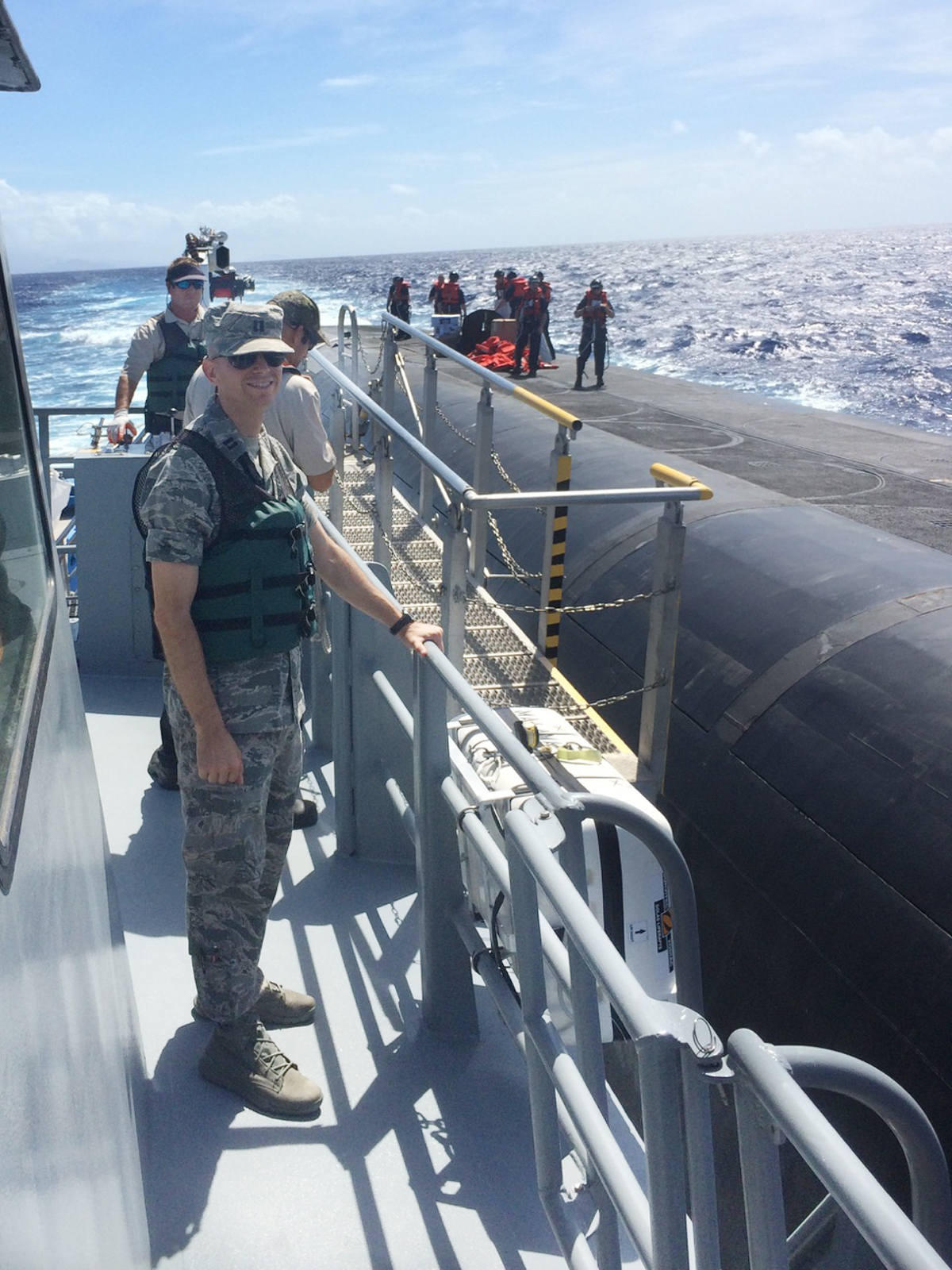
Capt. Cody daMota, one of the first four USAF officers selected for the Striker Trident nuclear officer exchange program, stands aboard the Personnel Transfer Vessel Malama during an open-ocean personnel transfer with a ballistic missile submarine, Aug. 15, 2015. Air Force photo by Capt. Patrick McAfee.
The first batch of nuclear officers have nearly completed the Striker Trident program—an exchange program between Air Force missileers and the Navy’s nuclear communities.
Four Air Force officers were selected for the program and are stationed with nuclear submarine operators in Norfolk and Hawaii. Two Navy officers are currently assigned to Air Force Global Strike Command, with one at AFGSC headquarters in Louisiana and one with 20th Air Force in Wyoming.
The idea for the office exchange dates back to 2008 from the Schlesinger Task Force, which was created after the Air Force mistakenly transferred nuclear cruise missiles from one base to another and played a significant role in the creation of Global Strike Command, said Terry West, the program manager at AFGSC. The target officer group for the program was midlevel captains who have hit about the 6.5-year mark of commissioned service, plus or minus a year, and have done two tours in the ICBM field.
Going forward, officers will be board selected for Striker Trident and West said they’re planning to stagger selections to mix experience levels within the program.
“These are high performing officers and potential Air Force leaders,” West said.
Designed as a three-year program, participants spend time at the national nuclear labs, US Strategic Command, Department of Energy, and with other major players in the nuclear deterrence community, West said. They also meet with top officers including one on one time with Gen. Robin Rand, AFGSC commander.
At the two-year mark, if officers have a chance for a Joint Staff position or to serve as an executive officer, they’ll be allowed to leave the program.
Maj. John Mayer was among the first officers selected for the program and has spent the last two years with the commander of Submarine Force Atlantic in Norfolk, Va. This summer, he’s headed to the Air Officer Commanding program at the Air Force Academy. His replacement will arrive at Norfolk in early 2017. He recommends that any eligible missile officer consider applying for the program.
Mayer was at 20th AF and working on many of the changes related to the Force Improvement Program in 2014. Striker Trident has been a great way, he said, to study organizational culture and the similarities and differences between the nuclear communities of the two services.
“Many of the pressures are the same,” Mayer said. “They have a longer history of human beings trying to do things with zero defects allowed.”
Striker Trident is intended to develop officers who will likely hold Joint Staff jobs or commands within the nuclear force and give them a broader understanding of the overall nuclear deterrence mission and the nuclear triad.
Mayer said he and his fellow Striker Trident officers share their experiences with the Navy officers they’re stationed with and their fellow missileers, and as the saying goes, the grass isn’t always greener.
Mayer said he hasn’t pulled alert in 4.5 years and the culture is changing, but “historically, we think we’ve got it worse than everybody else. I personally would not trade the Great Falls, [Mont.] weather for the deployment schedule [submariners] have. A terrible alert might turn into 48-72 hours, but then you come back and see your family. They have better weather, but the deployment schedule is unbelievable to me.”
And the submariners also think they have it pretty rough, so Mayer said he and another missileer stationed in Norfolk point out the challenges of life at the northern tier bases and ICBM jobs.
“My message to my peers, and what I’ll teach at the Air Force Academy, is everybody makes sacrifices, everybody thinks they have it the worst, but it’s not true, there’s always cost and compromise. We need to have humility about our one role in this big enterprise, everybody’s working extremely hard.”